Key takeaways:
- Soil and water conservation is essential for ecosystem balance, with effective techniques like contour farming and mulching improving soil health and moisture retention.
- Implementing soil management practices, such as crop rotation and cover cropping, significantly boosts crop yield and environmental health while supporting local economies.
- Community engagement in conservation efforts, like local cleanups and education on sustainable practices, fosters collective action and lasting changes for environmental stewardship.
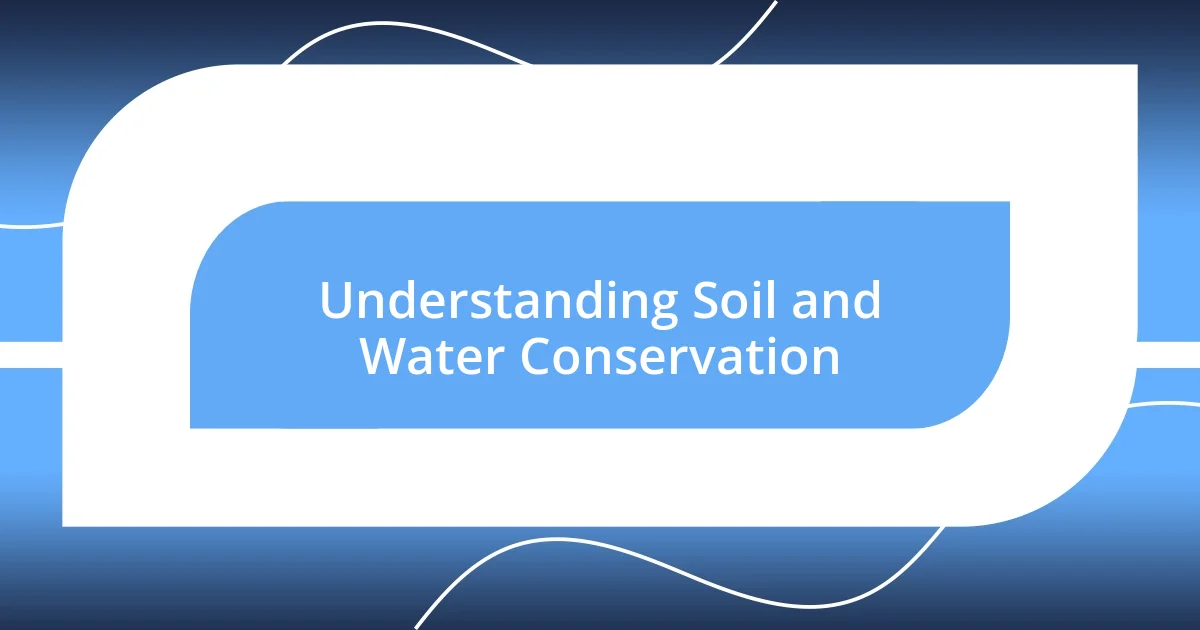
Understanding Soil and Water Conservation
Soil and water conservation is fundamentally about maintaining the balance within our ecosystems. I remember walking through a community garden, observing how the soil was rich and dark, while the plants thrived with vibrancy. It struck me that this wasn’t just luck; it was the result of intentional practices aimed at nurturing both soil and water.
When I first learned about techniques like contour farming and mulching, I was fascinated. These methods do more than just prevent erosion; they improve soil structure and retain moisture. Have you ever tried gardening after a heavy rain? You might notice how well irrigation works when the soil is cared for, making me wonder—what if more people understood the value of these practices?
One of the most poignant moments I experienced was visiting an area affected by severe drought. It was heartbreaking to see once-fertile land turned to dust. This experience truly highlighted for me how crucial effective soil and water conservation strategies are not only for agriculture but also for sustaining communities and ecosystems. Understanding these principles can be a game-changer—don’t you think?
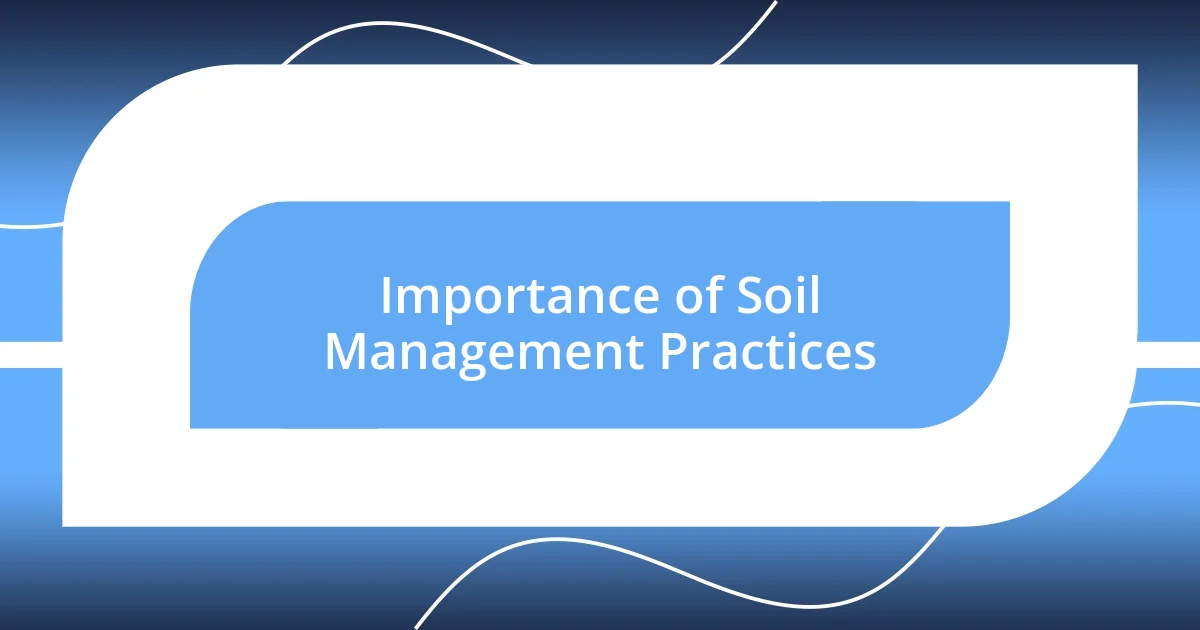
Importance of Soil Management Practices
Soil management practices are essential as they directly influence crop yield and land productivity. I remember my neighbor, a small-scale farmer, incorporating crop rotation in his fields, which resulted in healthier plants and better soil quality. Seeing the difference firsthand made me realize that simple management strategies can profoundly impact both our environment and the food supply.
Effective soil management also contributes to environmental health. During my hiking trips, I often see how poor soil management leads to deterioration of water bodies due to runoff. It pains me to witness this degradation, but it reinforces the idea that by adopting practices like cover cropping and reduced tillage, we can protect water resources and promote biodiversity. Isn’t it remarkable how our choices can ripple through nature?
Lastly, investing in soil management pays long-term dividends. I once attended a workshop where experts shared success stories from regions that embraced sustainable practices. It was inspiring to hear how soil fertility was restored, revitalizing local economies and creating job opportunities. This made me reflect on the critical nature of proactive soil management—not just for today’s harvest but for Future generations as well.
| Soil Management Practice | Benefits |
|---|---|
| Crop Rotation | Improves soil health and prevents pests |
| Cover Cropping | Reduces erosion and enhances biodiversity |
| Reduced Tillage | Improves moisture retention and soil structure |
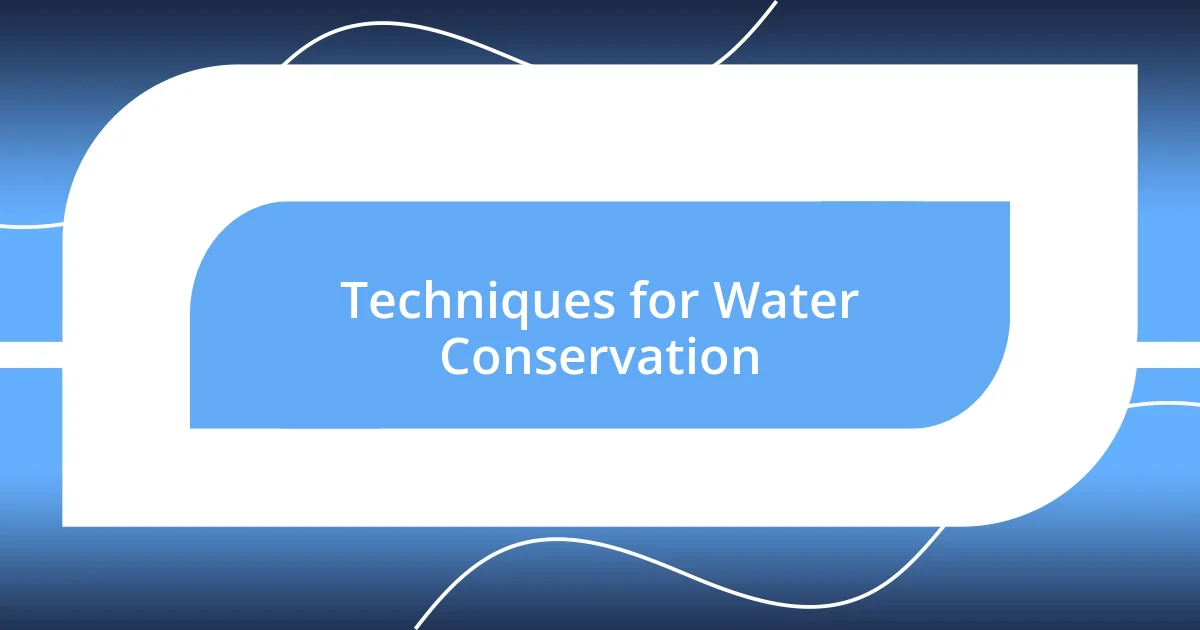
Techniques for Water Conservation
I recall a hot summer day, when my friends and I visited a local orchard that practiced rainwater harvesting. It was fascinating to see how they collected runoff from roofs into barrels, then used it to irrigate the trees. This technique revealed to me just how resourceful we can be with water management, especially in times of scarcity. Incorporating such strategies not only conserves water but also ensures plants get the moisture they need without wasting a drop.
Here are a few effective techniques for water conservation that I’ve learned:
- Drip Irrigation: This method delivers water directly to the plant’s roots, minimizing evaporation and runoff. It’s a real game-changer for efficient watering.
- Rain Barrels: Collecting rainwater from rooftops allows for irrigation while reducing dependency on municipal water sources.
- Mulching: A thick layer of organic material on the soil surface retains moisture, suppresses weeds, and enhances soil health.
- Soil Moisture Sensors: These devices help gardeners water only when necessary, preventing overwatering and encouraging deep root growth.
Thinking back on my own gardening efforts, I now understand how vital these practices are. Using these techniques has made my plants flourish while easing my worries about water waste. It’s humbling to see that small changes can lead to big benefits, both for my garden and the environment.
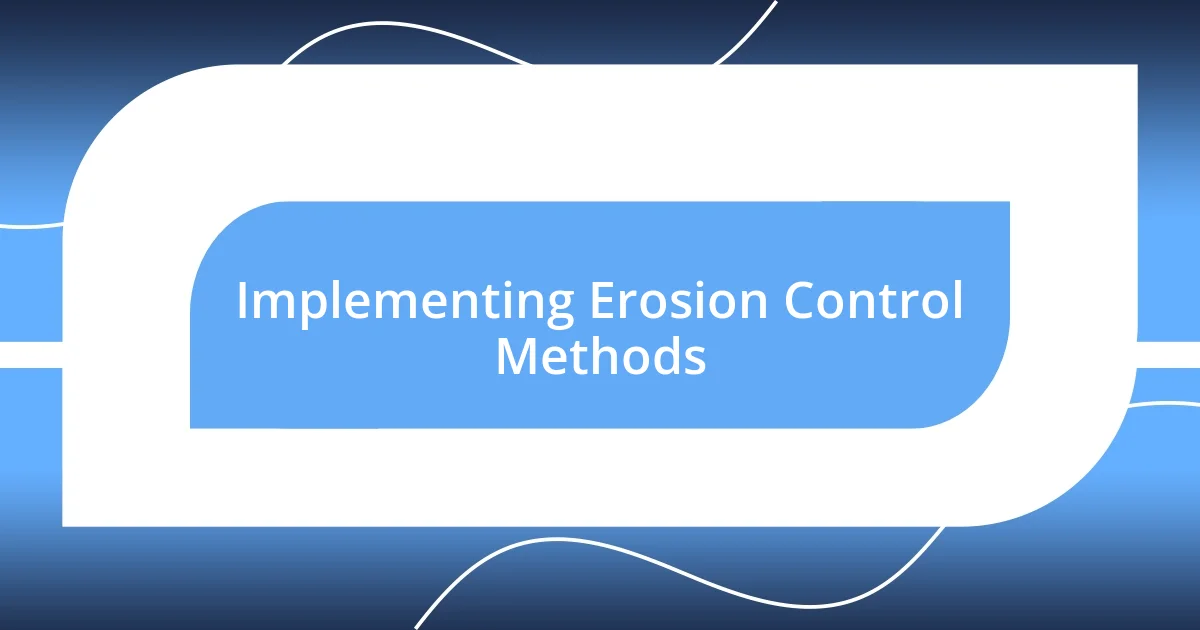
Implementing Erosion Control Methods
Implementing erosion control methods is crucial not just for preserving soil but also for maintaining the integrity of our local ecosystems. I vividly remember a day spent volunteering at a community garden where we installed silt fences. It was surprisingly eye-opening! Watching the rainwater flow gently away from the newly planted beds, instead of washing away precious soil, made me appreciate the effectiveness of simple, practical solutions. Have you ever considered how something as straightforward as a fence can make a difference?
When I think about other erosion control techniques, methods like planting grass strips or using terraces come to mind. There’s something satisfying about establishing a line of native grasses along a hillside; it transforms the landscape while helping to stabilize the soil. I once took a trip to a hillside vineyard where they had terraces running down the slope. The vineyard owner shared how maintaining these terraces not only protects the soil from erosion but also enhances the quality of their grapes. It was a perfect example of how erosion control can intertwine with agriculture and yield beautiful results.
Overall, I’ve learned that combining different methods can yield the best outcomes. In my own backyard, I’ve experimented with both cover cropping and building raised beds. I noticed that not only did these techniques reduce erosion but they also enriched the soil with organic matter. Isn’t it incredible how these interconnected practices can create a more resilient environment? Each small action we take addresses erosion’s impact and helps us preserve the land for future generations.
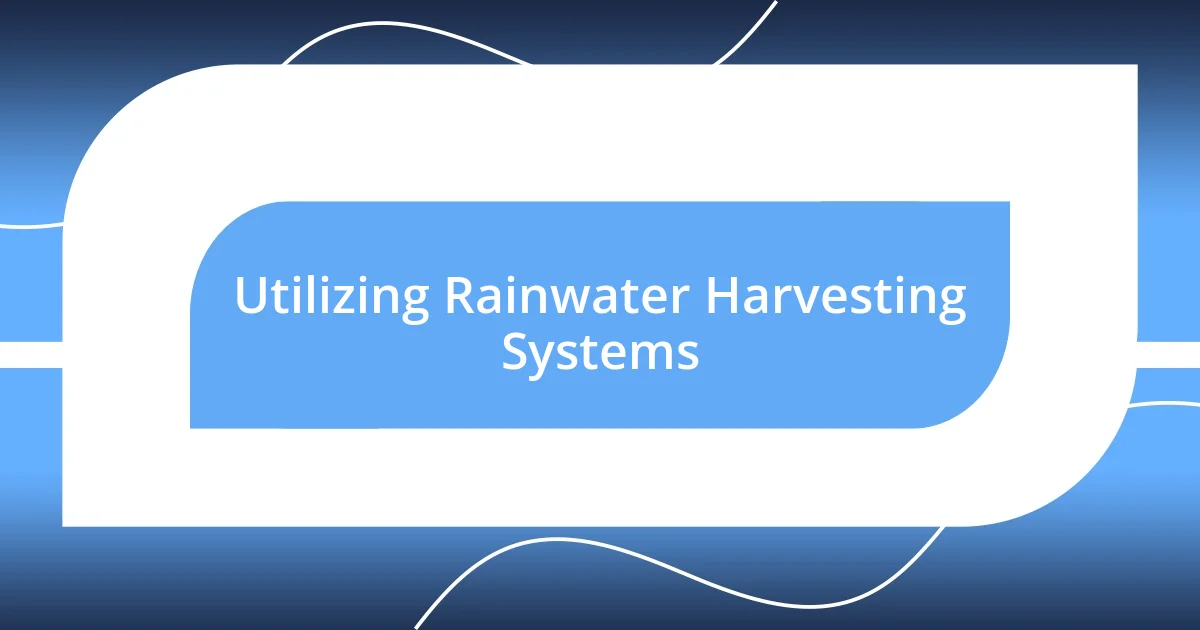
Utilizing Rainwater Harvesting Systems
Utilizing rainwater harvesting systems has transformed my approach to gardening. I remember visiting a friend who had a beautifully designed rainwater catchment system. It was so inspiring to see the way they filtered rainwater from their roof and directed it into a large cistern. Not only did they have a reliable water source during dry spells, but the ease of using collected rainwater for their vegetable garden was a revelation. Have you ever experienced that satisfying feeling of knowing you’re making the most of nature’s resources?
When I started my own rain barrel project, I was amazed at how quickly it filled up after a good rainstorm. Watching the water pool in my barrel felt like capturing a piece of the sky. I soon realized that every drop can make a difference, especially during the drier months. It’s like having a secret stash of liquid gold for the plants. Plus, utilizing rainwater helps reduce runoff and minimizes erosion – a win-win for both my garden and the planet.
As I’ve delved deeper into the world of rainwater harvesting, I’ve learned the importance of maintenance. Cleaning out the gutters and ensuring the system is free of debris requires a bit of effort, but it’s undoubtedly worth it. I often ponder how these simple practices can lead to significant shifts in water conservation. Do you think incorporating such systems in urban settings could also relieve pressure on local water supplies? I genuinely believe that every small change counts, and it excites me to think about the potential impact of more people embracing rainwater harvesting.
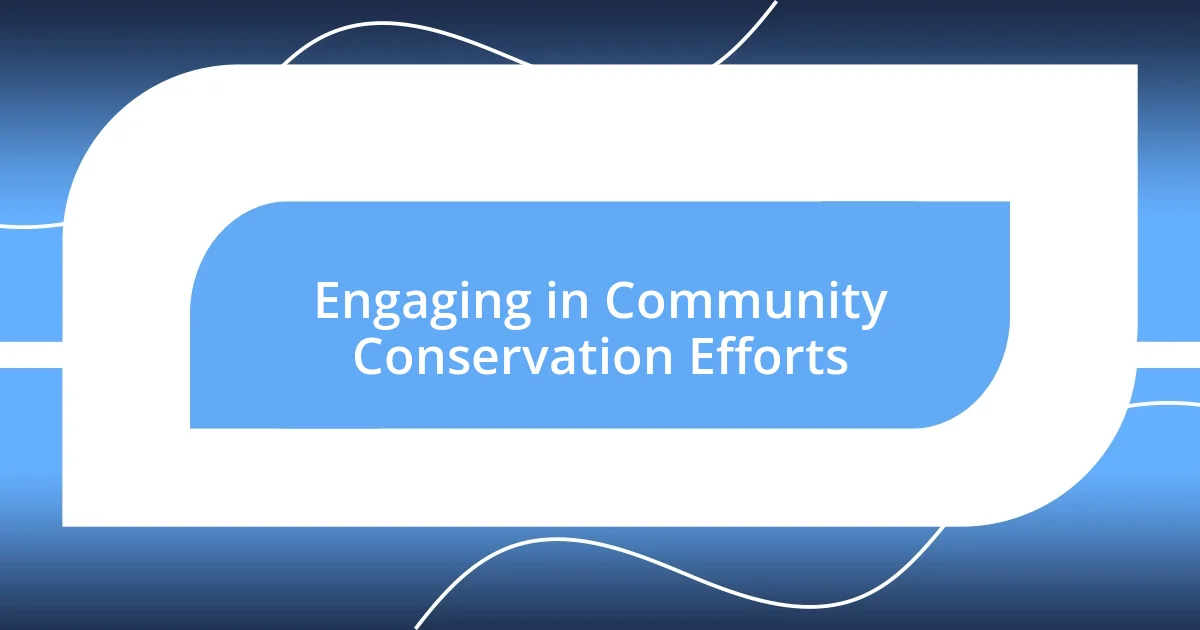
Engaging in Community Conservation Efforts
Engaging in community conservation efforts has provided me with profound insights into the power of collective action. I distinctly remember joining a local cleanup day along a riverbank, where neighbors came together with enthusiasm and purpose. The feeling of camaraderie while picking up litter and restoring the natural beauty of our surroundings was contagious! Have you ever participated in an event that made you feel deeply connected to your community and environment?
What struck me the most during that day was how education played a vital role in our efforts. Many participants learned about the impact of pollution on soil and water quality as we worked side by side. I found myself sharing tips on native plants and their role in biodiversity, and it was inspiring to see everyone getting excited about planting more trees in their own yards. Have you experienced that moment when someone realizes they can directly contribute to their local ecosystem? It’s exhilarating!
In my experience, these community initiatives often spark conversations that lead to lasting changes. After that cleanup, our group initiated a monthly meeting to discuss sustainable practices, and I can still feel the energy in the room. People began implementing small changes, like reducing plastic use and composting, echoing our commitment to conservation. I believe it’s these connections that empower us to make a genuine impact. Wouldn’t it be amazing if we all engaged in our own communities like this?












